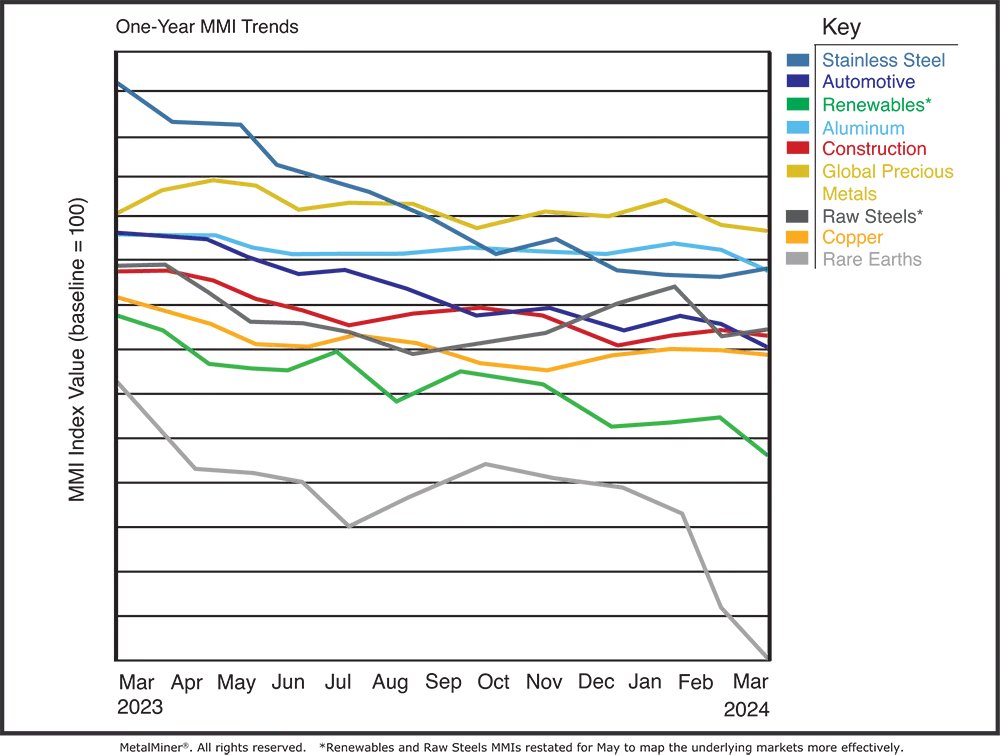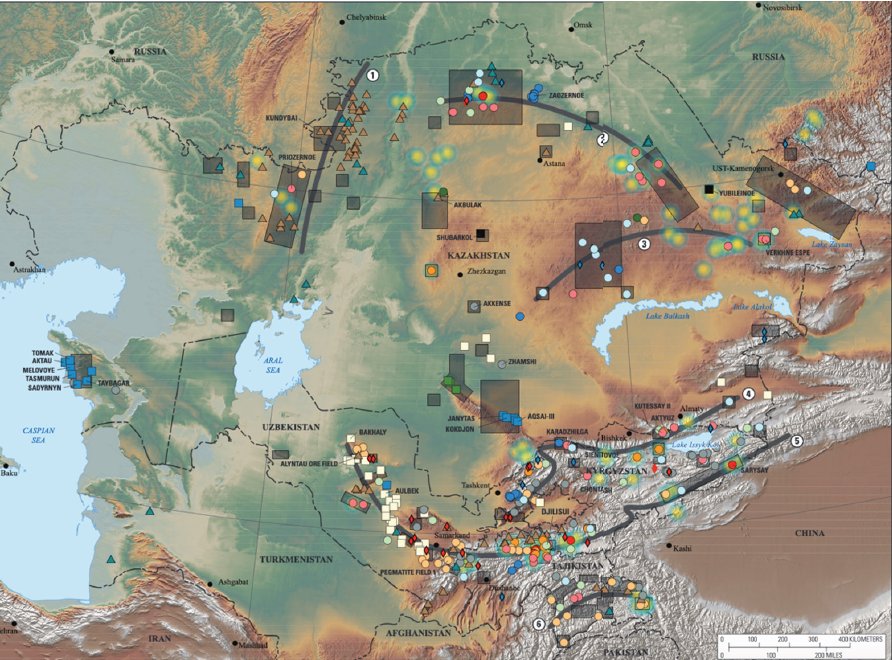


This article explores three critical inquiries: Firstly, we assess the strategic position of Central Asian nations within the rare earth metals’ geopolitical landscape. Secondly, we identify the risks and prospects these states encounter amid the competitive scramble for these resources. Lastly, we evaluate the capacity of international players to contest for Central Asia’s mineral riches, highlighting the region’s pivotal role in global resource politics.
Central Asia boasts a significant share of the world’s essential minerals, holding 38.6% of its manganese ore, 30.07% of chromium, 20% of lead, 12.6% of zinc, and 8.7% of titanium, alongside other valuable resources. Kazakhstan, in particular, emerges as a contender against China’s dominance in rare earth elements production, which accounts for 70% globally. The country shows promise in extracting metals like scandium, yttrium, and the 15 lanthanides, crucial for producing computers, turbines, and automobiles. This potential has attracted the attention of the United States and the European Union, both keen to invest in Kazakhstan’s mining projects to reduce their reliance on Chinese rare earths. Currently, the US heavily imports yttrium and scandium, whereas the EU gets 98% of its rare earth supplies from China.
The Race for Central Asia’s Resources: Can Foreign Powers Secure a Stake?
The United States and China are locked in a contest for Central Asia’s vital minerals, marking a shift in American engagement tactics in the region. Moving away from areas traditionally dominated by Russia and China, the U.S. is now zeroing in on critical resources. In September 2022, under the Biden administration, the U.S. rolled out the Economic Resilience Initiative for Central Asia (ERICEN), earmarking $25 million for the year to foster trade diversity and bolster regional investments. Meanwhile, at the May 18-19, 2023, China-Central Asia Summit, Chinese President Xi Jinping pledged $4 billion in financial aid to the region, underscoring the geopolitical stakes. This period also saw a growing realization within the U.S. and EU that their heightened engagement with Central Asia might be too little, too late, facing stiff competition from Russia and China in security and economic spheres.
In September 2023, the U.S. hosted the “US-Central Asia” summit, a significant development given that just a year prior, in 2022, the Kazakh President had met with European and corporate leaders at the 77th UN General Assembly but not with President Joe Biden. This summit was distinct in its focus and outcomes. A post-summit analysis revealed that securing access to Central Asia’s rare earth metals was a primary objective. The summit’s C5+1 joint declaration on September 20, 2023, underscored the aim to forge diverse, sustainable, and reliable critical mineral supply chains, innovate in mining and raw material processing, and foster regional industrial cooperation to lessen strategic dependencies. Notably, this emphasis on critical minerals was not present in previous U.S. strategic documents for Central Asia, neither in the 2019-2025 strategy nor in the individual country strategies published by the U.S. State Department in 2022.
The arena of critical resource exploration, extraction, and processing is emerging as a battleground for the U.S. to counter Russian and Chinese sway. The U.S. has ramped up its involvement notably, hosting the inaugural C5+1 Critical Minerals Dialogue (CMD) with top officials from all five Central Asian nations on February 8, 2024. The dialogue saw a mutual eagerness to delve into prospects for American investment in the region’s critical mineral sectors. Further underscoring this focus, U.S. Secretary of State Anthony Blinken and Kazakh Foreign Minister Murat Nurtleu engaged in discussions on mineral investments in Kazakhstan on March 26, 2024. An increasing volume of analyses by American experts signals a growing U.S. interest in Central Asia’s critical rare earth elements, setting it apart from other nations’ focus. This heightened attention to American perspectives stems from their timely and accessible nature. Additionally, the 2024 Annual Threat Assessment of the U.S. Intelligence Community underscores that:
“China views Washington’s competitive measures against Beijing as part of a broader U.S. diplomatic, economic, military, and technological effort to contain its rise, undermine CCP rule, and prevent the PRC from achieving its regional and global power ambitions.“ (p. 7)
What constraints could impede China’s technological and economic march, particularly in high-tech realms? On March 5, 2024, Premier Li Qiang, addressing the National People’s Congress, outlined China’s pivot towards a new development paradigm, earmarking significant investment for technological innovation and advanced manufacturing. This shift, echoing President Xi Jinping’s vision for fostering “new productive forces,” encompasses pivotal sectors like microchip production and defense technology, both heavily reliant on critical resources. In this context, the U.S. strategy appears to pivot towards diminishing reliance on China for these essential materials, concurrently aiming to curb Chinese firms’ ability to broaden their resource bases. As the Caspian Policy Center points out, the escalating Sino-American competition casts the U.S.’s dependency on China for critical minerals as a strategic Achilles’ heel. Dominating nearly 60% of global rare earth mining and over 85% of processing capabilities, China’s potential to leverage its quasi-monopolistic stance in critical minerals poses a significant threat to the U.S.’s high-tech and defense sectors. This was underscored by Beijing’s December 2023 move to restrictexports of certain minerals and related technologies. Yet, some analysts see Central Asian nations as viable contenders in challenging China’s rare-earth metal supremacy.
For China, safeguarding its strategic dominance and thwarting U.S. and allied efforts to tap new critical resource reserves are paramount, especially within the context of global power dynamics. This strategy was underscored following French President Emmanuel Macron’s tour of Kazakhstan and Uzbekistan on November 1-2. Post-visit, Uzbekistan’s Minister of Mines and Geology, Bobir Islamov, revealed a strategic partnership between Uzbekistan and the French firm Orano, with Orano committing to a $500 million investment in uranium extraction and processing in the country. Concurrently, on November 7, Uzbekistan’s Navoiuran and the China National Nuclear Corporation cemented a strategic memorandum for cooperation in the uranium sector, highlighting the intense international competition for critical resources.
In the arena of critical resources, the ability to mine and refine raw materials emerges as one of key battlegrounds for Western nations vis-à-vis China. This relatively uncharted territory presents Central Asia with the chance to scale up its rare earth element extraction, potentially reducing its reliance on Chinese expertise and investment. However, the landscape is complex; despite the region’s untapped potential, Chinese firms currently dominate, holding the majority of mining licenses for critical minerals in Tajikistan and Kyrgyzstan, as observed by U.S. analysts.
In the competition for Central Asia’s critical resources, China and the United States bring distinct strategic advantages to the table:
China:
United States:
In the Resource Rivalry, What Risks and Rewards Lie Ahead for Central Asia?
Competition among the great powers for access to critical resources in Central Asia presents a mix of risks and opportunities for the countries of the region. Central Asian countries, with their vast reserves of critical minerals and rare earth metals, can play a key role in the global pursuit of technological progress and energy transition. This scenario unfolds in a broader geopolitical context where these countries are positioned between the interests of major powers such as China, the United States and, to a lesser extent, Russia and the European Union.
Opportunities for Central Asian countries:
Risks for Central Asian countries:

The place of Central Asian countries in the geopolitics of rare earth metals
Central Asian countries are gradually coming to the forefront of the geopolitical arena related to the extraction and distribution of rare earth metals and are trying to respond accordingly. Thus, the President of Kazakhstan Kassym-Jomart Tokayev in his annual Address to the People of Kazakhstan called forensuring priority rights to subsoil use to investors who carry out geological exploration at their own expense, adding:
“One of the priority tasks should be the development of deposits of rare and rare-earth metals, which have essentially turned into “new oil”. The countries that will be able to realize their potential in this area will determine the vector of technological progress of the entire world”.
In 2012, the U.S. Geological Survey began assessing the mineral potential of rare earth elements in Central Asia, concluding in 2016 with a list of 384 deposits. This included locations in Kazakhstan (160), Kyrgyzstan (75), Tajikistan (60), Turkmenistan (2) and Uzbekistan (87). The Tien Shan and Pamir regions have also attracted exploration attention given their significant undeveloped resources.

Источник: отчет Географической службы США “Rare Earth Element and Rare Metal Inventory of Central Asia”. Карта в полном виде также предоставлена в аналитическом отчете каспийского политического центра “Sourcing Rare Earth Minerals in Central Asia”.
It is currently known that monazite, zircon, apatite, xenotime, pyrochlore, allanite and columbite are among the most common rare metals and minerals in Central Asia. These metals occur in significant quantities, particularly in areas such as the Kazakh steppe, the Tien Shan and Pamir mountains. The potential for mining rare earth elements in Central Asia is significant, which indicates that the development of these resources is promising. Even at this stage, according to a report by the International Energy Agency, the share of minerals and metals in Kyrgyzstan’s total exports is over 50%, while Uzbekistan and Tajikistan have over 30%.
Each of the minerals listed plays a critical role in modern technology and industry, from electronics and energy to aerospace and agriculture, emphasizing the critical importance of rare earth elements and related minerals in advancing technology and supporting global economic development. It was not possible to find exact data on the share of rare earth metals in the world located in Central Asia, but it was not possible to obtain a rough understanding by analyzing data on exports of ores, metals, precious and non-monetary stones. Such data on Central Asian countries is provided by the UN Conference on Trade and Development (UNCTAD).

https://www.datawrapper.de/_/wzzH2/
As Figure 2 shows at this stage, in a generalized form, exports of ores, metals and gemstones are not concentrated on only one of the possible actors, such as China, but are unbalanced between the two major consumers, although Asia's share is gradually increasing. Unfortunately, it is not possible to find more detailed data. As noted by Wesley Hill, head of the international program on energy, growth and security at the International Tax and Investment Center, China does not yet control rare earth mining in Central Asia, despite Chinese activity in the region and China's dominance in mining and processing these resources.
Conclusions
The intensifying competition for critical resources in Central Asia, primarily involving the United States and China, underscores the region's growing strategic importance in the global supply chain for rare earth metals and key minerals. Central Asia's vast reserves of these resources make it a potential counterweight to China's current dominance in the production and processing of rare earth elements needed for high-tech, renewable energy, defense, and automotive industries.
The United States has placed increased emphasis on diversifying sources of critical minerals to reduce dependence on China, as evidenced by initiatives such as the Economic Resilience Initiative for Central Asia (ERICEN) and the C5+1 Critical Minerals Dialogue. These efforts aim to create sustainable and reliable supply chains, promote regional industrial cooperation, and encourage exploration, mining and processing of critical minerals in Central Asia.
On the other hand, China seeks to maintain its strategic position and prevent the U.S. and its allies from accessing new sources of critical resources, as seen in its economic clout in the region and strategic partnerships, such as with Uzbekistan in uranium mining.
Main photo: Rare Earth Element and Rare Metal Inventory of Central Asia.
This site uses cookies. By continuing to use the site, you accept the cookies we use to serve you better. More Information
OK, I Understand.